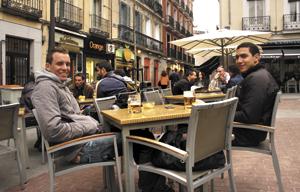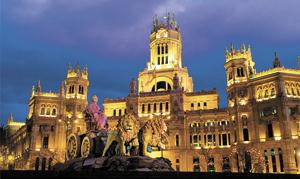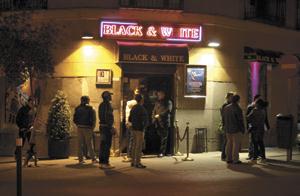
Outdoor cafés are great for people watching.

Plaza de Cibeles and City Hall.

Madrid's nightlife starts late.

Madrid boys with their dog.
Madrid, the bustling cosmopolitan capital of Spain, offers a breathtaking journey through time with its impressive monuments, palaces, fountains, religious houses and city squares. The city’s architecture is a pastiche of styles and eras; traces of the old Arab and medieval cities remain, mixed in with structures built during the time of the Hapsburgs, Bourbons and King Charles III, known as the “bricklayer king.”
The Cuchilleros Arch is the most famous of nine gates into Madrid’s main square, Plaza Mayor. It connects to La Cava de San Miguel, a street full of bars and restaurants where you can enjoy a wide range of Spanish culinary delights (see sidebar).
Tapas, small appetizer portions of various dishes, is a staple in Spanish cuisine. The locals, known as Madrileños, dine late and commonly have these small plates after work to tide them over until a 10 or 11pm dinner.
There are many tapas spots to choose from in the old town, in the Sol, La Latina, Plaza de Santa Ana, Cava Baja, Cava Alta and Plaza Mayor areas. There are a handful of great gay-owned and -friendly restaurants throughout the city, such as Carmencita and Divina la Cocina, in the Chueca neighbourhood; Arroceria Gala and Paelleria Vallenciana, in Puerta del Sol; and Gula Gula, on the Gran Via, to list a few favourites.
After a late-night meal, the vibrant club and nightlife scene awakens; the strumming of Spanish guitars echoes in side streets as Euro-pop builds inside the heaving clubs.
Neighbourhoods
The main gay neighbourhoods are Chueca, in the old quarter, and Barrio, located in the centre just off Gran Via. The majority of gay venues are situated in the maze of small streets around Plaza Chueca and onward toward Gran Via. The area around Metro Lavapiés also has a cluster of clubs and restaurants.
A number of gay-owned and -friendly bars, cafés, restaurants, boutique shops, clubs and clothing stores are located in both areas. Same-sex kissing and handholding are common sights in these neighbourhoods, and in the city in general.
Gran Vía and Paseo de la Castellana are two of Madrid’s most famous streets and offer an unparalleled shopping experience, with Gran Vía known for its antique shops and charming cafés. Paseo de la Castellana is the place to go for deluxe hotels, art galleries and specialty boutiques.
Culture
Madrid Gay Pride, or Orgullo in Spanish, is one of the largest Pride celebrations in Europe. It features a massive Saturday parade (this year it takes place on June 30) from Puerta de Alcalá to Plaza de España. Participants and viewers along the two-kilometre route number about 1.5 million people each year. Most of the Pride parties and celebrations are held in the Chueca neighbourhood, a short walk from the city centre. The Pride Festival, on the leafy Plaza de España, starts after the parade, from about 6pm onward; the Plaza Chueca street parties attract as many as 300,000 people.
The Madrid Card is a great option for visitors who want to take in the major tourist attractions. It offers free entrance to more than 50 museums, the Discover Madrid walking tours (organized by the tourist board), the Teleférico cable car, the Real Madrid museum tour, a number of shows, and discounts in various restaurants and shops. Visit madridcard.com for more information.
The Golden Triangle of Art consists of three world-renowned museums that are home to some of Spain’s most famous works of art: Museo del Prado, Spain’s main art museum, which houses some of Europe’s finest paintings and sculptures, including works by Spanish artists Velázquez and Francisco de Goya; Museo Nacional Centro de Arte Reina Sofía, Spain’s museum of 20th-century art, known for its collections of Pablo Picasso (most famously Guernica) and Salvador Dalí; and Museo Thyssen-Bornemisza, which fills in the gaps left by the other two.
Getting around
Madrid is a walker’s city, so be sure to allow plenty of time for strolling. The Metro is big, cheap (1.50 euros per single trip; day passes available) and efficient. English is the second language on the signs and maps are free at the ticket booths. The Metro closes overnight, with most stations opening at 6am. Some stations, such as Puerta del Sol, open at 5am, with commuter lines for the airport or Atocha Station intercity trains. Local buses are also a good option; they operate from approximately 6am–11:30pm and run in special lanes on the city’s main streets. White-and-red-striped taxis run day and night; look for the city crest and a licence number on the side. If the green light is on, the car is available.
Getting there
More than a dozen airlines service Madrid out of Toronto, including non-stop flights on Air Canada and Lufthansa and one- and two-stop flights through US and European cities. Madrid’s Barajas Airport is about seven miles east of the city. The airport is connected by Metro Madrid Line 8 to the city, with stations at the terminal buildings. It takes about 50 minutes and less than $5 to reach the Chueca station, with two line changes.
NOTABLES PLACES TO VISIT
Cuchilleros Arch
Neptune Fountain
Teatro Real
Puerta del Sol
Puerta de Alcalá
Plaza de Oriente
Plaza Mayor
Royal Palace of El Pardo
SAVOUR THE FLAVOURS
While in Madrid, sample these tasty Spanish dishes:
Tortillitas de camarones: shrimp fritters made with chickpea flour
Spicy chorizo sausage and cheese tortillas: delicious hot or cold
Costillas: barbecued mini-ribs
Ceviche: fish/seafood marinated in lime juice
Artichoke-rice croquetas with manchego cheese
Prawn croquetas with béchamel
Cocido: chickpea stew
Torrijas: fried bread with honey or sugar
TRIP ADVISOR
Bars & Clubs
Bears Bar
Griffin’s Dance Club
Lodgings
Hostal Puerta del Sol
Petit Palace Ducal Chueca
Restaurants & Cafés
Divina la Cocina
Momo
Saunas & Sex Clubs
Sauna Octopus
Sauna Paraiso
Shopping & Services
Juan, Por Dios!
Different Life Book/Sex Shop
With files from Guidemag staff.

 Why you can trust Xtra
Why you can trust Xtra